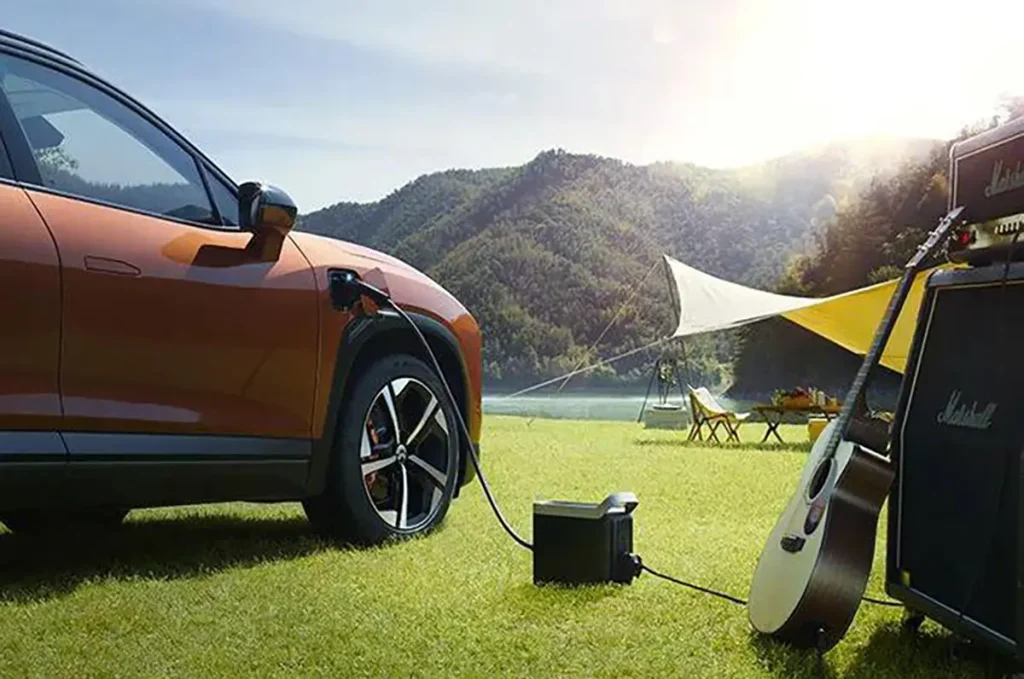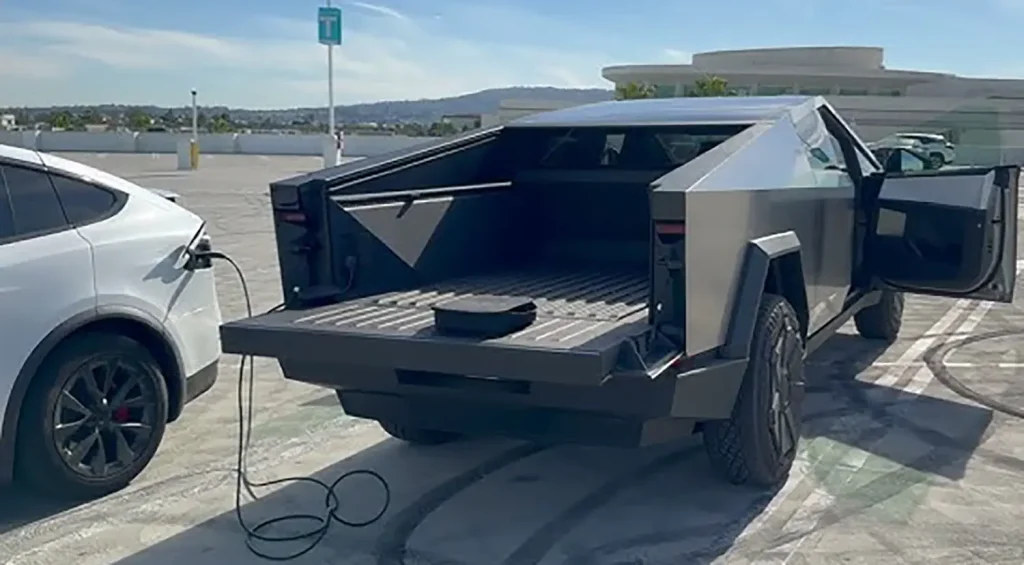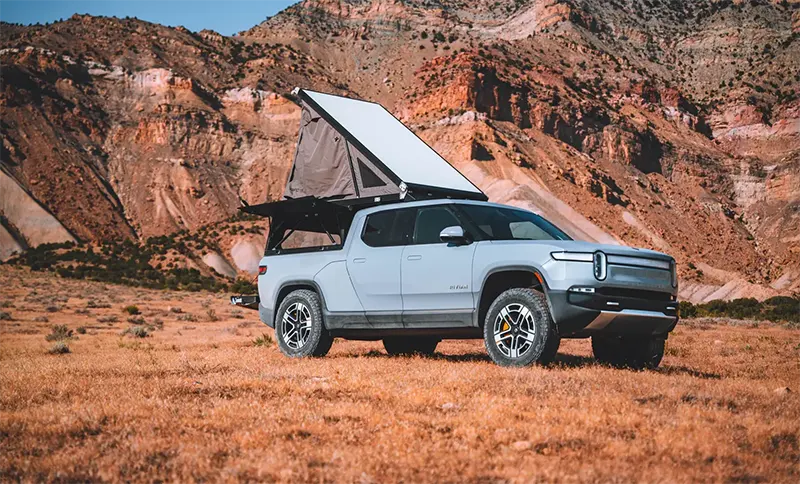
Learn how Vehicle-to-Load (V2L) transforms your EV into a mobile power source for camping, home backup, and remote work.
Well, for the longest time, a car was… just a car. It got you from A to B. But what if your car could do more? What if it could power your laptop on a camping trip, run a coffee maker at a tailgate, or even keep your refrigerator running during a power outage?
This is not some futuristic speculation; it’s a feature available right now in many new electric vehicles. It’s called Vehicle-to-Load, or V2L.
V2L is one of the most practical, and perhaps overlooked features of the modern EV revolution.
But what is it, exactly? And how is it different from all the other ‘V2’ acronyms popping up?
We’re here to break it down. You’d be surprised at how simple, and how useful, it really is.
1. What is V2L, Exactly?

Vehicle-to-Load, or V2L, is a feature that allows your electric vehicle to function as a mobile power source. It essentially turns your EV’s high-capacity battery into a giant, portable power bank, allowing you to plug in and power appliances, tools, and other electrical devices directly from your car.
Now, you might be thinking, “My gas car has a 12V socket, what’s the big deal?” That’s a fair question. But we’re talking about a completely different league of power. That 12V socket (the old ‘cigarette lighter’ port) can barely handle a phone charger or a small tire inflator. It’s running off the car’s small 12-volt accessory battery.
V2L, on the other hand, utilizes the main traction battery—the same massive lithium-ion pack that moves the car. It uses an inverter (often, the car’s own onboard charger running in reverse) to convert the battery’s high-voltage DC power into standard AC household electricity—the same 120V (in the U.S.) or 230V (elsewhere) that comes from a wall socket.
The “Load” in V2L literally means any electrical load or device you’d normally plug into a wall.
2. The V2X Family: V2L vs. V2H vs. V2G
V2L is part of a bigger family of technologies, all bundled under the acronym “V2X,” or Vehicle-to-Everything. It’s a confusing space, so let us clarify.
V2L (Vehicle-to-Load)
As we’ve covered, this is the simplest. It’s one-way power out of the car, directly to a device. Think of it as using a portable battery pack to charge your phone. Simple, direct, and temporary.
In the U.S., all V2L-capable systems must comply with NEC Article 625, which governs EV power transfer and safety standards.
V2H (Vehicle-to-Home)
This is the next step up. As the name implies, it allows your EV to power your entire house. This is a far more complex setup. It requires a special, hard-wired home charging station and an automatic transfer switch that safely disconnects your home from the grid.
V2G (Vehicle-to-Grid)
This is the big one. Vehicle-to-Grid is a two-way street. It not only powers your home but can, in principle, send power back to the electrical grid. This concept is the cornerstone of true bidirectional charging and relies on a bidirectional EV charger to communicate with the utility. The idea is to help stabilize the grid. Your car could charge at night when electricity is cheap (off-peak) and then sell a little power back during peak hours. Honestly, it’s a whole different economic and infrastructural ballgame.
All in, V2L is the feature you can use today, anywhere. V2H and V2G are, for now, more about home energy management and future grid infrastructure.
3. How Does It Actually Work?

Getting the power out of the car is straightforward and typically done in one of two ways:
- Interior Sockets: The simplest method. Some EVs, like the Hyundai Ioniq 5 or Kia EV6, just have a standard household power outlet built right into the cabin (often on the back of the center console or in the trunk). You just… plug things in. It’s that easy.
- The V2L Adapter: This is the more common—and arguably more powerful—method. The car’s charging port (the same one you use to charge the car) is bidirectional. You plug in a special adapter, and voila, that port becomes a high-power outlet.
Now, not all V2L is created equal. The power output is measured in kilowatts (kW). A car might offer 1.9 kW of power, which is plenty for running laptops, lights, a small TV, or charging e-bikes. It’s basically a standard 15-amp wall socket.
Other systems, particularly on trucks like the Ford F-150 Lightning (with its “Pro Power Onboard”), can offer 3.6 kW, 7.2 kW, or even 9.6 kW. For example, Ford demonstrated the F-150 Lightning powering a full home in Texas for three days during a grid outage in 2023. At that level, you’re not just running a laptop; you’re running power tools, an electric grill, or even a Level 2 charger for another EV. It’s a proper mobile worksite.
And don’t worry, the car is smart. You can (and should) set a limit—say, “Stop using V2L when the battery hits 20%”—so you’re never left stranded.

4. How to Use V2L (Vehicle-to-Load)
Using V2L is, in principle, as simple as plugging an appliance into a wall.
Activation Steps (Varies by Brand): It’s not always “plug and play.” Activation methods differ, so check your manual.
● BYD and Hyundai: These vehicles typically use a V2L adapter that has its own on/off button. You plug the adapter into the car’s charge port, plug your appliance into the adapter, and then press the ‘on’ button to start the power flow.
● MG EVs: MGs, on the other hand, are often controlled from inside the car. You’ll need to access the main touchscreen, navigate to the vehicle settings, find the V2L option, and press ‘start’ or ‘discharging’ on the screen.
Using V2L in an Outage: This is where V2L really shines. It’s a silent, fume-free backup generator. During an outage, you can run essentials. People have successfully powered a fridge, a coffee machine, and kept their phones charged, all from their EV.
You might be worried about draining your car, but running a few essentials like a modern refrigerator and a modem requires surprisingly little power. It’s estimated to use only about 10% of the car’s battery per day. That means you could potentially power essentials for at least 5 days and still have range to get to a charger.
Important Usage Warnings:
● Check Your “Tank”: Always make sure the car is fairly charged up before you start relying on it. As a rule of thumb, never use V2L when your battery percentage drops as low as 15%. You always want to leave a safe buffer for driving.
● Car On vs. Off: V2L is generally used when the car is off, but this is not universal. Check your owner’s manual for your specific model’s instructions.
● Finishing Up: When you’re done, remember to press the ‘off’ button on the adapter or ‘stop’ on your car’s screen to stop the discharge.
● Stuck Adapter? If your V2L adapter or charging cable ever gets stuck in the port, don’t panic. A quick double-press on the ‘unlock’ button on your car’s key fob will usually release the locking pin.
A Note on Whole-House Power: Important: This guide is for powering individual appliances via extension cords. This is not a DIY manual for powering your whole house. Attempting to back-feed your home’s electrical panel is extremely dangerous and could damage your car, your home’s wiring, or even harm utility workers. For any kind of whole-house load integration, you must consult with a licensed electrician to have a proper transfer switch installed.
5. Real-World Examples

So, what would you actually do with this? Let’s get specific.
- The “Campsite Hero” / Tailgating: Forget noisy, smelly gas generators. With V2L, you can quietly run an electric cooler, a projector for an outdoor movie night, an electric kettle for morning coffee, or, yes, the infamous blender for campsite margaritas.
- The Digital Nomad / Remote Work: Why work from a coffee shop? Pull up to a scenic overlook, plug your laptop and mobile hotspot into your car, and you’ve got the world’s best office. We’d argue this alone is a game-changer for a certain kind of lifestyle.
- The Home Emergency Backup (V2L-style): We’ve established this is not V2H, but that being said, V2L is a massive comfort during a power outage. Run an extension cord inside and you can keep the essentials going: the refrigerator (saving hundreds in spoiled food), your internet modem, and a few lights. In a pinch, this is well worth the price of admission.
- The “Good Samaritan” / EV-to-EV: Oddly, yes, you can use V2L to charge… another EV. You would not get a full charge, but you can absolutely give a stranded friend enough juice to get to the nearest fast charger. It’s the ultimate ‘jump start’.
6. Can Any Electric Car Do V2L?
The answer is, unfortunately, no. This is probably the most important thing to know if you’re investing in an EV right now.
You can’t just assume every electric car has this feature. The feature requires specific hardware (chiefly, a bidirectional inverter) and the software to manage it.

A Tesla, for example, does not offer V2L (at least, not as of this writing), despite being a leader in battery technology. This is a deliberate design choice, as their ecosystem is more focused on Powerwall and home energy. The one exception, however, is the Cybertruck, which offers a similar feature called “Powershare.”
Automakers like GM and Toyota have announced plans to include V2L capabilities in future models, signaling wider adoption across the U.S. market.
7. Which Cars Support V2L?

This feature was popularized, in particular, by Hyundai and Kia, but it’s now showing up in many new models. As of writing, here are some of the common V2L-capable vehicles:
● Hyundai Ioniq 5, Ioniq 6
● Kia EV6, EV9, Niro EV (newer models)
● Genesis GV60, Electrified GV70
● Ford F-150 Lightning (with Pro Power Onboard)
● Chevrolet Silverado EV (and other Ultium trucks)
● Rivian R1T / R1S
● Tesla Cybertruck (Powershare)
A quick note: Always double-check the specific trim level, as V2L (or the adapter) is sometimes an optional extra.
8. Other Limitations and Considerations
Okay, let’s be honest. It’s not a magic bullet. On top of vehicle availability, there are a few other things to keep in mind.
- Battery Drain (The Obvious One): You are, after all, using the car’s ‘gas tank.’ A 1.5 kW load (like a big coffee maker) running for an hour will use 1.5 kWh from your battery. On a 77 kWh battery, that’s barely a 2% drop. But running a 2.0 kW space heater all night? You’ll definitely see the impact on your range. The car’s display will usually tell you exactly how much power you’re using.
- The Adapter: If your car uses the charge-port method, you must have the specific adapter from the manufacturer. It’s often an optional extra, so make sure to get it when you buy the car.
9. In Closing
So, Vehicle-to-Load is, in short, a fundamental shift in what a car is. It’s no longer just a consumer of energy; it’s a mobile, flexible, and powerful source of it.
This technology turns the single biggest (and most expensive) component of an EV—the battery—into a multi-purpose asset. And, we’d say, as more people realize the sheer, practical utility of having a silent, 70+ kWh power bank on demand, V2L would not just be a neat feature. It’ll be one of the core reasons why people buy an EV in the first place.
Perhaps the real question is not ‘what is V2L,’ but ‘what can’t you do with it?’
While V2L is fantastic for power out, you still need a reliable, fast, and safe way to put power in. A dedicated home charging station is the single best upgrade for any EV owner.
If you’re ready to make charging a seamless part of your daily life, take a look at Duevolt’s range of smart EV chargers.
